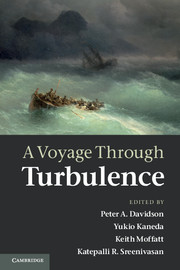Book contents
- Frontmatter
- Contents
- List of contributors
- Preface
- 1 Osborne Reynolds: a turbulent life
- 2 Prandtl and the Göttingen school
- 3 Theodore von Kármán
- 4 G.I. Taylor: the inspiration behind the Cambridge school
- 5 Lewis Fry Richardson
- 6 The Russian school
- 7 Stanley Corrsin
- 8 George Batchelor: the post-war renaissance of research in turbulence
- 9 A.A. Townsend
- 10 Robert H. Kraichnan
- 11 Satish Dhawan
- 12 Philip G. Saffman
- 13 Epilogue: a turbulence timeline
- References
6 - The Russian school
Published online by Cambridge University Press: 07 October 2011
- Frontmatter
- Contents
- List of contributors
- Preface
- 1 Osborne Reynolds: a turbulent life
- 2 Prandtl and the Göttingen school
- 3 Theodore von Kármán
- 4 G.I. Taylor: the inspiration behind the Cambridge school
- 5 Lewis Fry Richardson
- 6 The Russian school
- 7 Stanley Corrsin
- 8 George Batchelor: the post-war renaissance of research in turbulence
- 9 A.A. Townsend
- 10 Robert H. Kraichnan
- 11 Satish Dhawan
- 12 Philip G. Saffman
- 13 Epilogue: a turbulence timeline
- References
Summary
The towering figure of Kolmogorov and his very productive school is what was perceived in the twentieth century as the Russian school of turbulence. However, important Russian contributions neither start nor end with that school.
Physicist and pilot
… the bombs were falling almost the way the theory predicts. To have conclusive proof of the theory I'm going to fly again in a few days.
A.A. Friedman, letter to V.A. Steklov, 1915What seems to be the first major Russian contribution to the turbulence theory was made by Alexander Alexandrovich Friedman, famous for his work on non-stationary relativistic cosmology, which has revolutionized our view of the Universe. Friedman's biography reads like an adventure novel. Alexander Friedman was born in 1888 to a well-known St. Petersburg artistic family (Frenkel, 1988). His father, a ballet dancer and a composer, descended from a baptized Jew who had been given full civil rights after serving 25 years in the army (a so-called cantonist). His mother, also a conservatory graduate, was a daughter of the conductor of the Royal Mariinsky Theater. His parents divorced in 1897, their son staying with the father and becoming reconciled with his mother only after the 1917 revolution. While attending St. Petersburg's second gymnasium (the oldest in the city) Friedman befriended a fellow student Yakov Tamarkin, who later became a famous American mathematician and with whom he wrote their first scientific works (on number theory, received positively by David Hilbert).
- Type
- Chapter
- Information
- A Voyage Through Turbulence , pp. 209 - 237Publisher: Cambridge University PressPrint publication year: 2011
References
- 4
- Cited by



